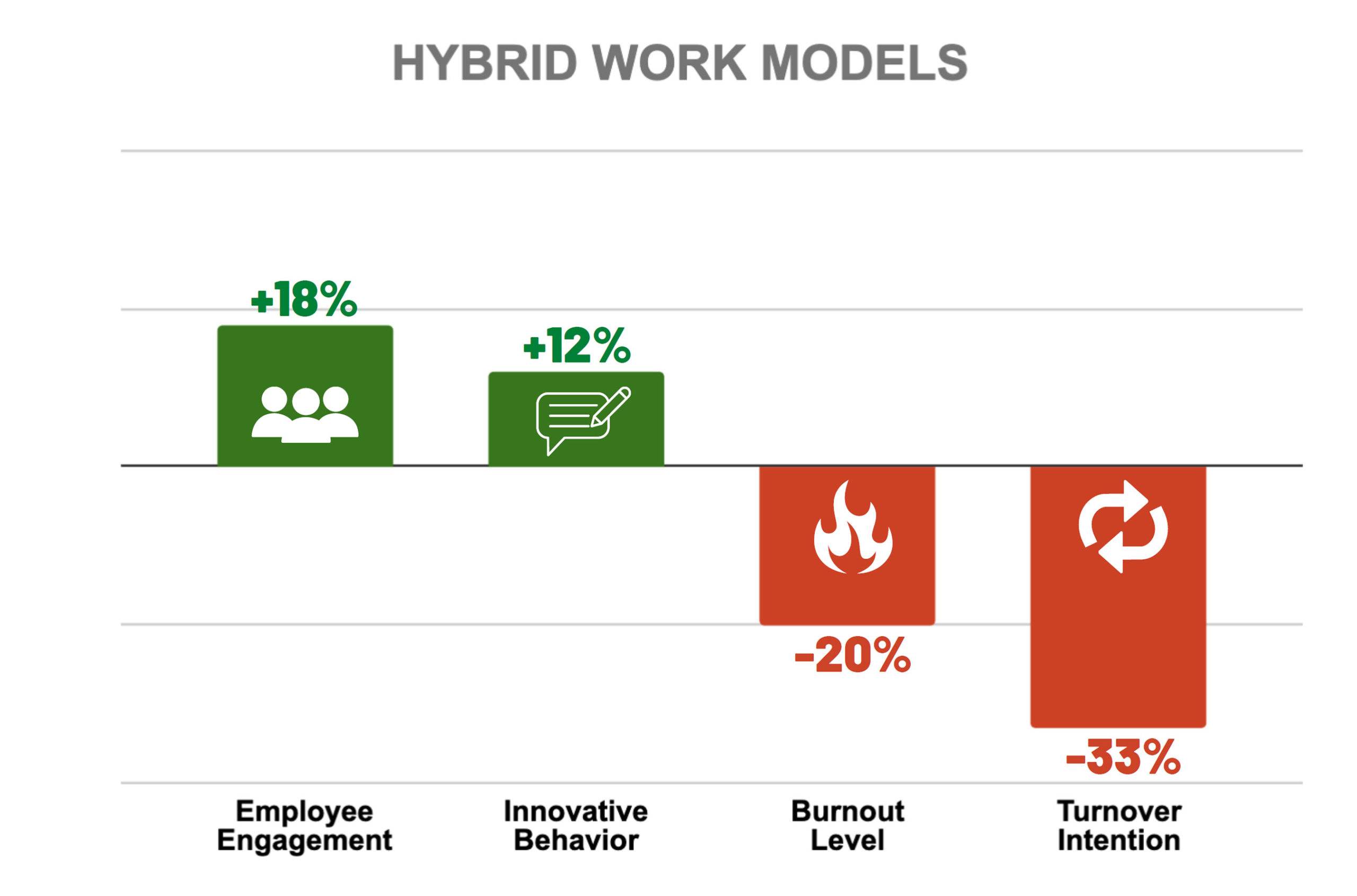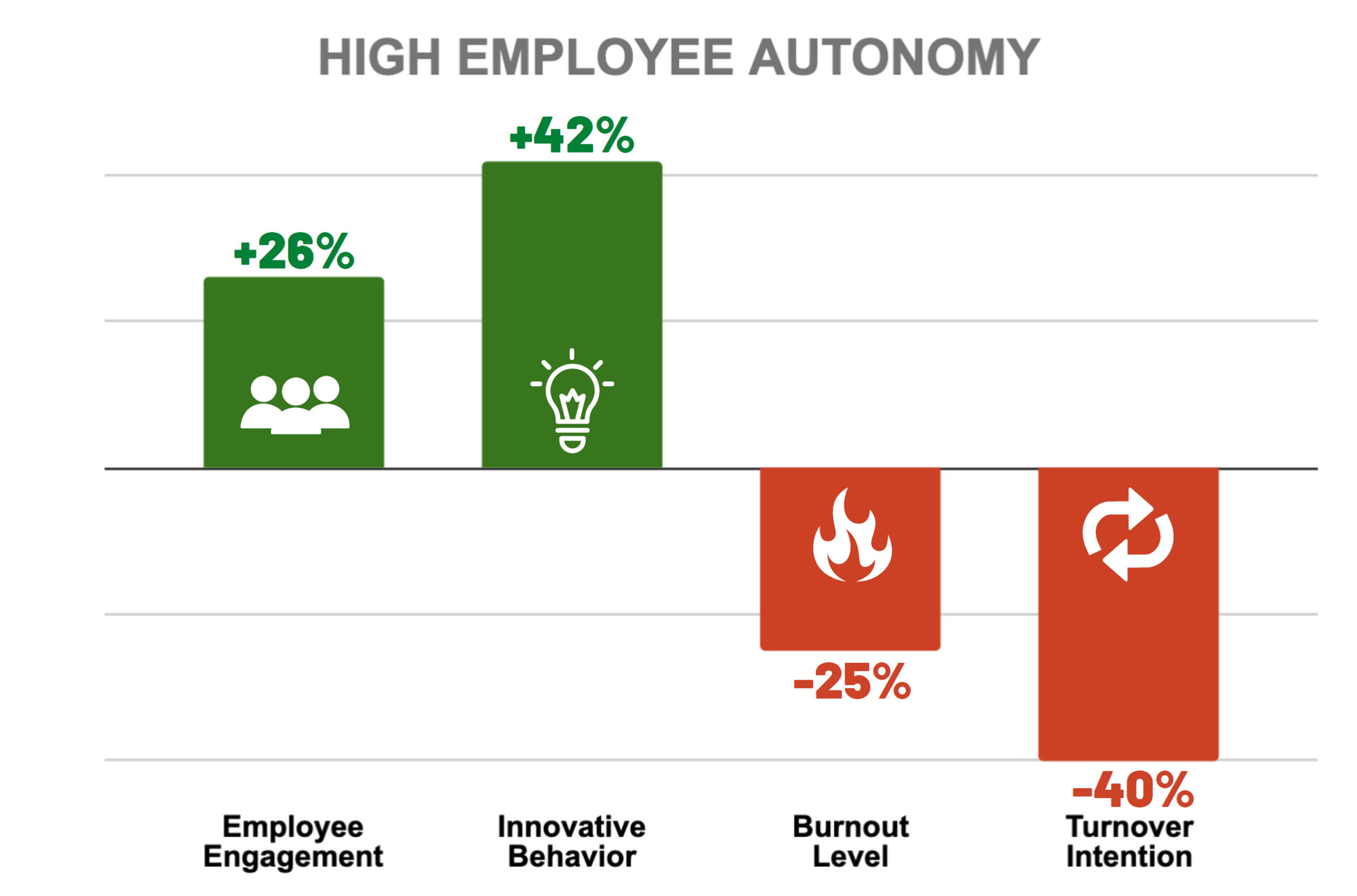The virtual workplace was a two-year experiment. Now, the next one begins: hybrid work. Partly in the office, partly from home—it seems to be the way forward. So how should organizational leaders support the hybrid work model to make the most of it?
To explore this question, we launched a longitudinal study of the U.S. workforce. Our results suggested that when employees felt their leaders actively supported the virtual work environment, they were more engaged and innovative, experienced less burnout, and were less likely to consider quitting (see figure).
 What is the takeaway? Merely changing your work-from-home policy is not the answer. Instead, the key is how your leaders support hybrid work. We will first discuss how to enable success virtually, then at the office, and finally how to bring it all together.
What is the takeaway? Merely changing your work-from-home policy is not the answer. Instead, the key is how your leaders support hybrid work. We will first discuss how to enable success virtually, then at the office, and finally how to bring it all together.
For pharma and biotech, this work model has specific consequences. In labs and manufacturing, hybrid work is not an option. Several pharma organizations and biotech companies successfully developed groundbreaking vaccines and treatments, saving the world with executives working from home and their frontline workers at the office or research facility. However, many of these workers are now burned out. Specific tools to help these groups are found in Step #4.
Step #1: Virtual Success—Virtual Work Enables Deep Work
Our research found that employees are more engaged and have an easier time concentrating while working from home. This is especially important for complex problem-solving tasks that require focused work for extended periods, such as programming, researching, writing, and analyzing data. The role of a leader in this case is to minimize distractions, roadblocks, and meetings on remote, deep-work days.
We also found that supportive and strong leaders improved engagement by 21% and reduced burnout by 59%. This was done by providing consistent feedback, prioritizing fairness, and displaying empathy.
To make the best use of “virtual” workdays for your employees, follow these tips:
- Fewer meetings, more focused work: Create policies that limit meetings to one to two hours a day. Set blocks of time that allow for undisturbed work. Save meetings for in-person days.
- Minimize distractions such as emails and check-ins: Avoid sending emails or checking in on your employees unless absolutely necessary.
- Skip the social events: Virtual social events rarely have the same benefits as non-virtual ones. Save socializing for in-person days.
Step #2: In-office Success—In-person Work Enables Group Creativity, Meetings, and Culture
In-person days should focus on collaborative work that cannot be replicated well virtually, such as brainstorming sessions, creative meetings, and longer discussions. In-person days are also an opportunity to build company culture and have fun. Plus, it allows you to build both team and organizational resilience so that when you hit difficult times, your team can stay strong and be productive.
To make the best use of your “in-person” workdays, follow these tips:
- Hold meaningful meetings to uncover new ideas. This is an ideal time to go deep, brainstorm, and debrief. Nothing replaces the productivity of in-person engagement.
- Create dedicated team rooms and dates to make it easy for teams to have the space and time to meet. You don’t want people sitting in cubicles by themselves.
- Build culture: Culture happens in person, so hold professional development opportunities in person and offer live Q&A with leadership to strengthen the alignment of your organizational mission and vision.
Step #2.5: Don’t Let the Two Bleed into Each Other
Just as people need work-life balance, they benefit from virtual and in-office balance. The type of work that is done from home ideally should not flow over to in-office days. It should be clear why both types of day exist. The bottom line:
- Separate virtual from in-person work. If you don’t separate virtual from in-person days, it is hard to justify why you need a hybrid workplace. So make sure to bring real, tangible benefits to each one.
Step #3: How They Work Together—Empowering Leadership
Our research points to the importance of your leadership style: how you show up, your vision, and how you remove roadblocks for your team. Building self-sufficient teams that take ownership over projects and timelines is essential in increasing organizational resilience and efficiency. Additionally, using different work models such as agile and hybrid are ways to give employees the flexibility and autonomy they crave.
To kick-start your empowering leadership:
- Care: Ask, listen, and respond. In unprecedented times, employees respond best to leaders who adapt to their concerns.
- Give ownership, gain big picture:Give ownership of more projects to your teams, and in turn, gain more big-picture oversight of your company. Your teams will appreciate the added responsibility, and you will have more time to focus on the bigger things at hand. It’s a simple trade that benefits everyone. As you can see in the figure below allowing your employees to have more autonomy in their work will drastically increase engagement and innovation while reducing burnout and turnover intentions.
- Fail faster and harder: Make failure acceptable—but fast. If teams fail fast, they learn quickly and are encouraged to take risks that will ultimately push innovation forward and benefit the organization.
- Celebrate wins and debrief mistakes: The first one is easy, yet often forgotten. The second one requires trust that can only be created by you as a leader. Mistakes are the best learning opportunities and should be dissected without blame.
 Step #4: How to Empower and Engage Frontline Staff
Step #4: How to Empower and Engage Frontline Staff
You know frontline workers need support and change. You just don’t know how. Some tips that go beyond providing massages are:
- Increase autonomy: We know that increasing each worker’s sphere of autonomy and influence will increase their accountability and Frontline workers aren’t able to have autonomy over where they work, but they can have autonomy in how they work. Consider empowering the autonomy of your frontline employees in regard to:
- Their daily schedule, based on the work that needs to be done
- The composition and responsibility of their teams
- Tracking performance and incentives with employee scorecards
- Revisit the flexibility of your employees’ work schedules: Allow for part-time work, and consider transition times. Empowered workers will give you their best performance. It’s better to have an energized worker for six hours than a burnt-out worker for eight. Many employees who are parents will thank you.
- Thoughtful acts go a long way: For example, you could send workers home with a family dinner every second week.
- Give a reason for your employees to be loyal: You could offer a loyal employee a three-month sabbatical after five years of work. Upon return, they could even host a session on what they learned and what they are now bringing back to the workplace. Time off can allow them to:
- Work at another site or department
- Study
- Work for a nonprofit that the organization supports
- Or simply mentally recharge
- Mentorship is the key to growth: Provide mentorship for younger staff, and they will reinvest in your organization.
- Further develop your staff: Provide development opportunities by sponsoring courses outside of the workplace or having lecturers visit you.
While there is no set formula for success in the hybrid workplace, or for reducing burnout among frontline employees, you can set your organization on the right path by managing the balance between in-person and virtual work and empowering an autonomous frontline staff. Flexibility and accountability are opportunities, not a roadblock. Embrace them, and you unlock the key to allowing your organization to thrive.












